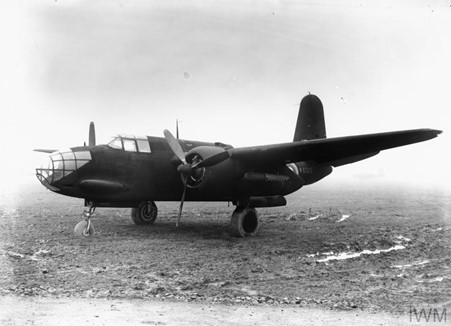
© IWM ATP 10695B
Boston Mark III (Intruder), W8325, at the Burtonwood Repair Depot, Lancashire, following conversion from a standard Boston Mark III. The aircraft served with No. 418 Squadron RCAF until 11 April 1943 when it failed to return from a night intruder mission over Melun-Villaroche, France.
General Facts
Crew: 3
Length: 47 ft 11.875 in (14.62723 m)
Wingspan: 61 ft 3.5 in (18.682 m)
Height: 18 ft 1.5 in (5.525 m)
Wing area: 464 sq ft (43.1 m2)
Empty weight: 16,031 lb (7,272 kg)
Gross weight: 24,127 lb (10,944 kg)
Fuel capacity: 400 US gal (330 imp gal; 1,500 l) normal capacity
300 US gal (250 imp gal; 1,100 l) in an optional external tank
676 US gal (563 imp gal; 2,560 l) in four optional auxiliary tanks in the bomb-bay
Powerplant: 2 × Wright R-2600-23 Twin Cyclone 14-cylinder air-cooled radial piston engines, 1,600 hp (1,200 kW) each
Propellers: 3-bladed Hamilton-Standard Hydromatic, 11 ft 3 in (3.43 m) diameter constant-speed fully feathering propellers
Performance
Maximum speed: 317 mph (510 km/h, 275 kn) at 10,700 ft (3,300 m)
325 mph (282 kn; 523 km/h) at 14,500 ft (4,400 m)
Cruise speed: 280 mph (450 km/h, 240 kn) at 14,000 ft (4,300 m)
Stall speed: 98 mph (158 km/h, 85 kn)
Range: 945 mi (1,521 km, 821 nmi)
Ferry range: 2,300 mi (3,700 km, 2,000 nmi)
Service ceiling: 23,700 ft (7,200 m)
Rate of climb: 2,000 ft/min (10 m/s)
Time to altitude: 10,000 ft (3,000 m) in 8 minutes 48 seconds
Wing loading: 52 lb/sq ft (250 kg/m2)
Power/mass: 0.141 hp/lb (0.232 kW/kg)
Armament
Guns: ** 6 fixed forward firing 0.5 in (12.7 mm) Browning machine guns in the nose
2 0.5 in (12.7 mm) Browning machine guns in dorsal turret
1 flexible 0.5 in (12.7 mm) Browning machine gun, mounted behind bomb bay
Bombs: 4,000 lb (1,800 kg)
One of the lesser known aircraft of WW2, they were used by 24 squadrons and operated in Europe as well as the Mediterranean and North Africa. The French had ordered several DB-7s, as the Boston lll was also known, and some were still undelivered by the time France had fallen. The RAF took up the remainder of the order, though they were concerned about the range. They were deployed in night fighter and intruder roles. There were two basic versions of the Havoc I, as the Boston lll was also known, an Intruder version (glazed nose, five 0.30-inch machine guns and 2.400 pounds of bombs) and a Night Fighter version (AI Mk. IV radar and eight 0.30-inch machine guns).
The French had originally intended to use the DB-7 as a short-range tactical attack aircraft, but its range was too short for the RAF to be able to use them as light bombers against German targets in Europe. But RAF was in desperate need of any aircraft suitable for night fighting and intruder duties. The type saw its first active operations with the RAF in early 1941, when 181 Boston IIs began to be deployed in night fighter and intruder roles.[20] There were two basic versions of the Havoc I, an Intruder version (glazed nose, five 0.30-inch machine guns and 2.400 pounds of bombs) and a Night Fighter version (AI Mk.IV radar and eight 0.30-inch machine guns). Eventually a British version that was designated DB-7B, RAF named it Boston III. The Boston III was the first to operate with the RAF as a light bomber. They were supplied to Squadrons in the United Kingdom. They were supplied to the Royal Canadian Airforce, 418 Squadron that had formed at RAF Debden while waiting for RAF Bradwell Bay to be completed.

© IWM CH 7210
Douglas Boston Mk III aircraft of No. 418 Squadron RCAF taxiing at Bradwell Bay, Essex, prior to a night intruder raid over France, September 1942

© IWM CH 7215
Douglas Boston Mark III, (Intruder) W8358 ‘TH-R’, of No. 418 Squadron RCAF flying off the French coast while heading back to its base at Bradwell Bay, Essex, after a night sortie over Europe. W8358 was eventually lost while on another night intruder sortie to Creil, France, on 8 November 1942.
Page content researched and written by Eric Simonelli. Page content converted and added to website by Paul Webb
